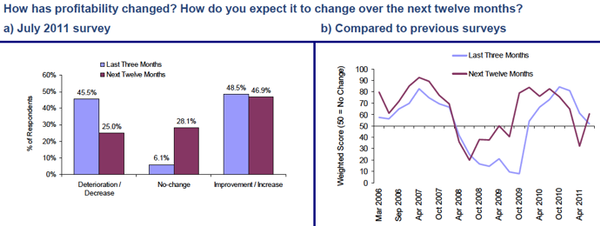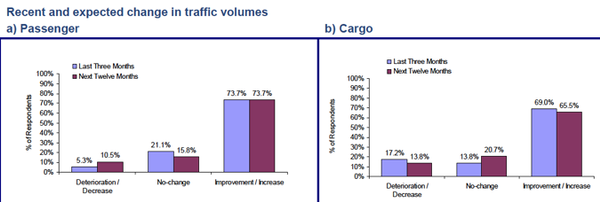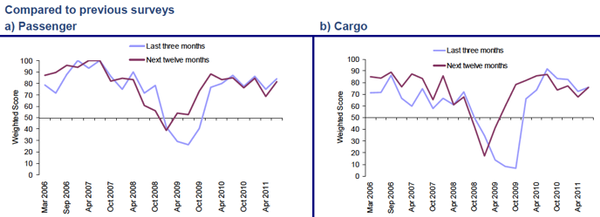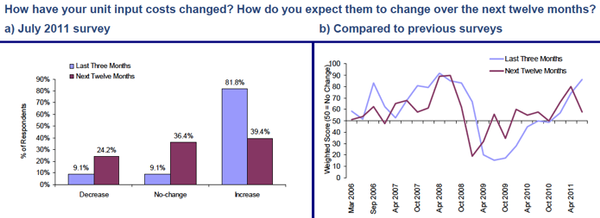Airline confidence in pricing deteriorates but some recovery in profitability outlook: IATA
The prospects for airlines to further raise fares waned in 2Q2011 although airline executives are upbeat about the next 12 months following a tough 2Q2011 in which profits felt the effect of events in the Middle East, North Africa and Japan, according to IATA in its Airline Business Confidence Index. The improved expectations on the profitablity outlook have occurred on the back of a positive outlook for traffic demand growth, reduced fears of further significant rises in fuel costs and optimism about the broader economic outlook.
- Profit margins were squeezed in 2Q2011, but there is some recovery in the profitability outlook for the next 12 months.
- Expectations of further sharp increases in fuel prices have dissipated, and traffic demand remains strong.
- Airlines have doubts about their ability to raise fares over the next 12 months due to weakening demand-supply conditions.
- Fuel costs remain a challenge, with prices peaking in 2Q2011, but expectations for further rises have fallen back.
- Industry employment continued to expand in 2Q2011, and further expansion is expected in the next year.
- Freight traffic is expected to accelerate in 2H2011, with the potential for growth due to increasing world trade.
Profit margins squeezed in 2Q2011 but some recovery in profitability outlook
Results from IATA's quarterly survey conducted in July-2011 show that while profit margins have continued to be squeezed in the second quarter, there has been some recovery in the outlook for profitability in the 12 months ahead. The sharp dip in confidence seen in the previous Apr-2011 survey was driven by expectations of further escalation in fuel prices and the demand shocks due to events in the Middle East, North Africa and Japan also dampened sentiment.
While fuel prices remain high, expectations of further sharp increases have dissipated and traffic demand remains strong, helping to drive the pick up in sentiment on future profitability, IATA noted.
A significant majority of respondents continued to report improved traffic volumes on both the passenger and cargo sides of the business during 2Q2011 with continued demand growth and capacity expansion expected in the next 12 months. While freight traffic has been volatile in the early months of 2011, freight levels increased in May-2011 and looks to be growing at an annualized rate of close to 4%. With world trade growing at around 6% there remains the scope for an acceleration in freight traffic during 2H2011, IATA noted. (See Appendix)
Yield improves in 2Q2011 but doubts exist over ability to raise fares
While yields improved during 2Q2011 as airlines attempted to offset rising fuel costs, the survey showed airlines have doubts over their ability to raise fares over the next 12 months as the capacity-demand balance tips. "With demand-supply conditions weakening and concerns that markets may not bear further fare and rate rises, prospects for yields over the year ahead look flat," IATA said.
Load factors are now down on their 2010 peaks, and with demand-supply conditions weakening, prospects for significant further yield increases are waning. Meanwhile, yield-boosting fuel surcharges are being held rather than increased (and in some cases reduced) while increasing capacity may reduce scope for underlying fare rises if passenger load factors fall as a result. IATA's own forecast is for a 3% increase in passenger yields over the course of 2011 - half the rise seen in 2010.
Fuel costs remains a challenge
Fuel costs remain a challenge, with airlines noted increased input costs during 2Q2011 driven by the rise in jet fuel prices. Jet fuel prices peaked during 2Q2011 at USD140 per barrel and averaged around USD133 per barrel in the quarter, nearly 50% higher than the average level the same quarter a year before. However expectations for further rises in input costs over the 12 months ahead have fallen back. Although fuel prices remain high, they have fallen from their Apr-2011 peak and airlines do not expect another significant step up in the price level.
IATA separately estimated a new fuel price average for 2011 at USD126.7 per barrel. This will add USD67 billion to the industry fuel bill compared to 2010 levels. According to IATA, increasing demand for oil pushed jet fuel prices up from USD88 a barrel at the start of 2010 to USD107 a barrel by year end. The 12-month average was USD91 a barrel, a rise of almost 30% from average 2009 levels. Hedging and fuel efficiency gains provided some protection but, even so, the airline industry fuel bill rose more than 11% to USD139 billion in 2010, equivalent to 26% of operating expenses. By the end of Mar-2011, driven largely by unrest in the Middle East, prices had risen even further, reaching USD130 a barrel, which corresponds to around 33% of operating costs. IATA's March forecast estimated an average 2011 price for fuel of USD96 a barrel, about 29% of total operating costs, with this estimate now being raised further.
IATA jet fuel monitor
Industry employment increase
Industry employment, meanwhile, continued to expand in 2Q2011 as operations increased to cater to growing demand. Further expansion is expected over the year ahead.
APPENDIX: IATA Airline Business Confidence Survey




